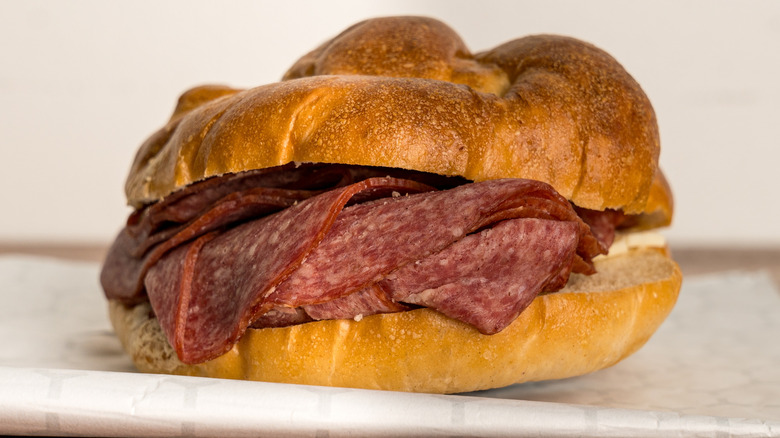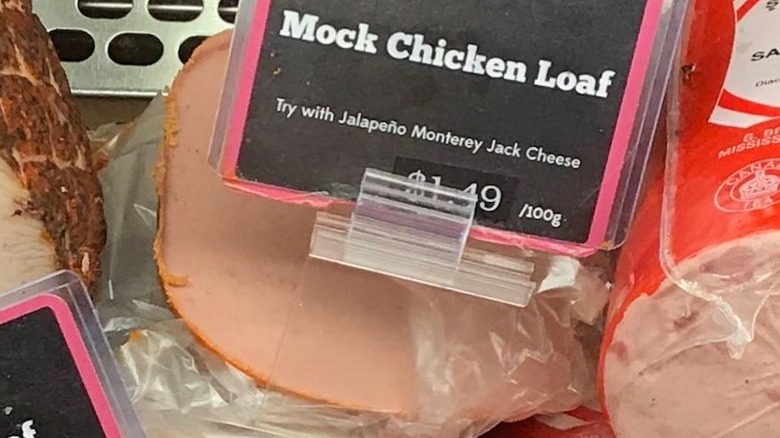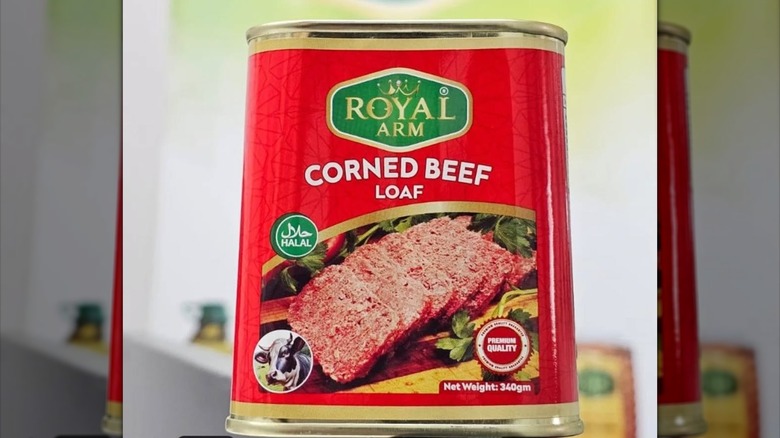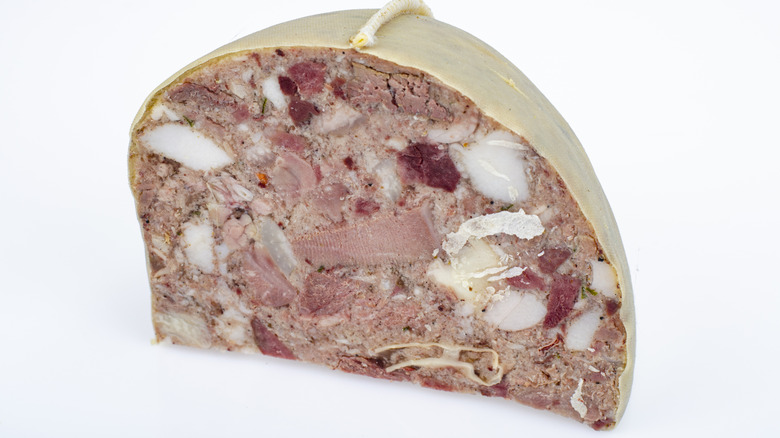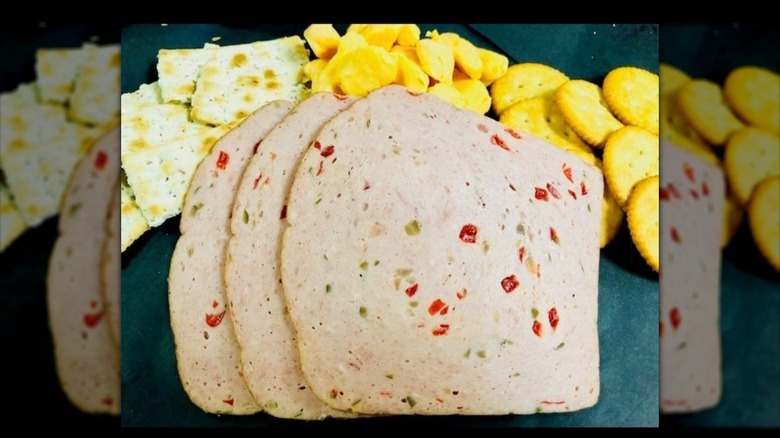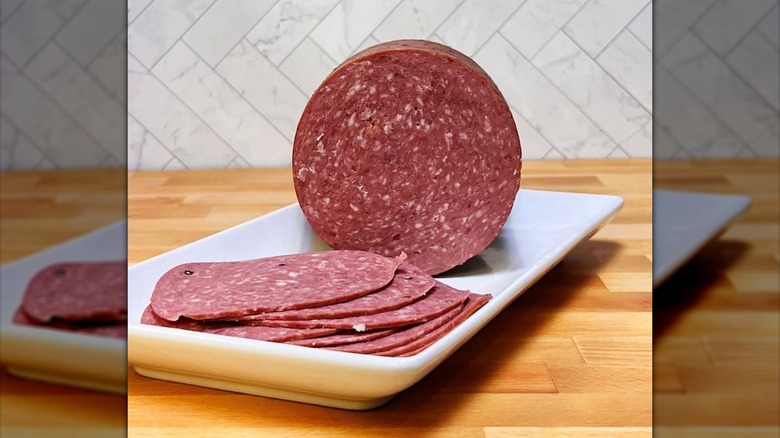Old-School Deli Meats Almost Everyone Has Forgotten About
The sandwich is the classic high-low food. It can be as fancy, special, and specific as one cares for it to be, or it can be the easiest, cheapest, and most slap-dash meal or snack possible. Sure, every state has a signature sandwich, there are once popular sandwiches that people don't really eat anymore, and there are cheap sandwiches from around the world that everyone should try. But, when hunger strikes and time and/or money are scarce, it's been the practice in the United States for the last 60 years or so to just root around in the drawer in the fridge, find whatever heavily processed and pre-sliced luncheon meat that's in there, take a bit, and slap it between two pieces of bread and add minimal condiments.
As real, whole meats have grown popular and become more readily available and affordable, the luncheon meat is increasingly a relic of a disappearing way of life. It wasn't that long ago that the neighborhood deli and supermarket packaged meat section were well stocked with dozens of choices of products derived from beef, ham, and pork and scientifically and industrially transformed into something modern and convenient. Here are some once top-selling luncheon meats that have virtually disappeared from stores and the collective consciousness.
Ham and cheese loaf
For decades, Oscar Mayer has been one of the leading names in processed protein and luncheon meats. Now a subsidiary of Kraft-Heinz, the hot dog and lunchmeat company makes a lot of ready-to-eat sliced meats, even as they grow more obscure, such as Ham and Cheese Loaf. With a name that suggests an all-in-one product that will deliver on the classic pairing of the ham and cheese sandwich, Ham and Cheese Loaf is way more about the ham than it is the cheese. Sold in square slices, it's made mostly of chopped ham pieces, pressed and formed into a loaf, which has been speckled with minuscule, bright orange pieces of processed American cheese, or "real Kraft cheese" as the package promises.
While increasingly forgotten, and sold only in one size (16-ounce packs of vacuum-sealed meat) Oscar Mayer Ham and Cheese Loaf's eventual and probably inevitable demise was hastened by a scandal. In December 2022, 2,400 pounds of the luncheon meat were recalled by the manufacturer. A production facility in Kirksville, Missouri, had failed to clean its equipment before churning out a run of Ham and Cheese Loaf, potentially contaminating a whole day's run of the product with germs that cause foodborne illness potentially left behind by undercooked meat.
Liverwurst
Liverwurst is a food of German origin, and it's technically a sausage on account of how it's made from a pig's organ meats (mostly liver) and pork fat. It's all finely ground up together and extruded into tubes. The finished product is soft enough that it works as a spreadable paste for bread or crackers, but firm enough that it can be used in slices or hunks on a sandwich. Liverwurst's popularity peak in the U.S. lasted from the 1940s to the 1970s, sold alongside bologna at deli counters and appearing in little cylinders in grocery store luncheon meat sections. It was so popular that it led to the embrace of another, similar sandwich filling called braunschweiger. That's merely liverwurst in all of its porky and fatty goodness that's been given an extra level of flavor through the smoking process.
By the 2020s, liverwurst had disappeared from the mainstream, even in deli hotbeds like New York City. After 2024, what little liverwurst that remained in distribution grew even more rare. One of the few companies still making it, Boar's Head, ended production after an outbreak of the foodborne pathogen listeria at a Virginia processing plant directly led to the deaths of nine people.
Olive loaf
Take a bunch of meat bits and other edible, fatty detritus leftover from industrial meat processing and packing, form it into a rounded rectangular shape, and to add some flavor, throw in some finely cut pieces of olive — both the sour and vinegary outer green part and the sweet and pickle-evoking inside red pieces called pimiento. That makes olive loaf, perhaps one of the most quintessential and polarizing of all the increasingly fading and once top-selling luncheon meats of the 20th century.
Made by the same companies that also produced things like bologna and hot dogs, olive loaf is similar to those meat products, just in a different physical form, with the ingredients varying greatly. Veteran meatpacker Hummel Brothers made it with pork, beef, and soy, while Oscar Mayer mostly used chicken, pork, turkey, and corn syrup. To keep the pieces of olive in place in the olive loaf, they were coated with milk powder, meaning the luncheon meat wasn't safe for the lactose intolerant.
Once a regular presence at deli counters, where it was often used to make a sandwich or sold freshly sliced for later use at home, olive loaf was a popular choice a couple of generations ago and even enjoyed a sales resurgence in the late 1990s. Very few meat producers even bother to make olive loaf anymore, with both Hummel Brothers and Oscar Mayer quietly discontinuing the former lunch staple.
Luxury loaf
The major influx of emigrants from Europe in the late 19th and early 20th centuries gave way to emigrants from Latin America and Asia settling in the U.S. in large numbers, expanding and transforming the food culture away from one bearing a heavy influence from European culinary traditions. German food no longer has the prominent stature in the U.S. that it once did, and with that means a fade into obscurity for formerly familiar German-originated deli meats.
For decades, a luncheon meat called Luxury Loaf was part of the lineup for industry leader Oscar Mayer. Sold under an anglicized name, the sliced and packaged sandwich meat resembled chopped ham, but with more dark meat included. The food itself was a mass-produced version of an old German meat called leberkase. Dating to the Bavaria region of the 1700s, butchers combined beef and pork flesh with pork liver, and then ground it so fine that it was like a sausage, and had a texture likened to bologna. After it's made into a loaf shape, leberkase is baked so that it may acquire a crusty topping. Traditional German delis and meat packers still sell their versions of leberkase, or luxury loaf, while Oscar Mayer stopped making it without fanfare sometime in the past few decades.
Beef Lebanon bologna
Bologna was once so omnipresent that the market could sustain numerous variations, including regional favorites and even products that didn't bear much similarity to the mildly flavored, sausage-like, sliced luncheon meat best known by that name. Take for example Lebanon bologna. Developed and popularized in the 19th century as part of the cuisine of the Pennsylvania Dutch community living and working out of Lebanon County, Pennsylvania, the meat has the reddish-pinkish hue of standard bologna but tastes more like salami, as it's traditionally hardwood smoked, noticeably cured, and fermented. It's got a smoky, slightly bitter, and powerful flavor, while the variant sweet Lebanon bologna is expectedly all of that with a bit of a sugary hit.
Rarely seen outside of Pennsylvania and surrounding states, it had faded into luncheon meat limbo both in its region of popularity and elsewhere. Specialty meat manufacturers still produce it, but it's not the major Northeastern food it once was.
Mock chicken loaf
Chicken isn't the most consumed meat in the world, but it sure is in the U.S. Massive, factory-farming operations keep Americans in a good supply of the wings, drumsticks, breasts, strips, nuggets, sandwiches, and grocery store rotisserie chickens that are in huge demand. Americans' embrace of affordable chicken is a relatively recent development, going back only about 50 years. Up until the mid-20th century, real, roast chicken was largely a special treat, grown on smaller or personal farms and the centerpiece of special occasion meals or Sunday family dinners. Eating chicken on the regular was so cost prohibitive for so many that if they wanted a taste of the stuff on a random weekday afternoon and didn't want to spend a lot of money, they could partake in the bologna-adjacent mock chicken loaf.
When chicken was rare and expensive, pork and beef were common and affordable. Those became the chief ingredients in mock chicken loaf, along with a whole lot of seasonings to make two hooved animals' flesh taste almost like poultry. Today, some of the few manufacturers who still produce the largely obsolete mock chicken loaf, use turkey as well as a bunch of fillers and preservatives, to approximate the taste.
Beef aspic
It's a notoriously off-putting dish, and despite modern recipes designed to cure fears of aspic, it remains the definitive example of a classical food that evolved into a weird or gross one as collective tastes changed. To make a beef aspic, for example combine beef stock with gelatin — acquired by boiling the bones of a cow or using a store-bought unflavored powder — to create a transparent jelly. It's then used to envelop meats, vegetables, and eggs, and the resultant jiggly loaf is sliced. It's like Jell-O with fruit pieces suspended in it, if the Jell-O was beef flavored and little bits of beef replaced the fruit.
Aspics of all kinds, particularly beef aspics, are so associated with dinner parties of the 1950s and 1960s that there isn't much market for premade, ready-to-eat ones in the 21st century. Some delis or grocery stores may still stock it and sell portions by the pound to those who are curious or miss the good old days when sliced beef gelatin was a viable and mundane sandwich foundation.
Liver cheese
For decades, Oscar Mayer sold a luncheon meat called Liver Cheese. Despite the name, it wasn't a hard sell of a mashup between liver, with its limited appeal and strong flavor profile, and cheese. It didn't include any of the latter item at all, but bore the consistency of a soft or processed dairy-based cheese. Oscar Mayer's Liver Cheese was inspired by various sausages from Eastern Europe or Germany, and was made smooth and speckled by the industrial mincing of pork, pork fat, pork livers, and a heavy load of spices and preservatives. Only tasting a little like overwhelmingly umami and fatty liver, Liver Cheese was a more savory kind of bologna that performed well on a sandwich or cut into smaller pieces for party trays or charcuterie.
By 2020, Oscar Mayer had slowed production on liver loaf without a lot of notice, as evidenced by confused and irate longtime customers posting online about the luncheon meat's sudden disappearance. It was around that time that the biggest name in processed meat stopped making and distributing liver cheese altogether.
Corned beef loaf
In the early 20th century, many of the foods that would become embedded into the culinary cultural firmament originated as recipes that appeared on the side of canned or packaged products developed in the manufacturer's kitchen as a way to drive sales. One such dish, apparently popular from the 1930s and for several subsequent decades: Corned Beef Loaf. Promoted and popularized in large part by a recipe book published by Jell-O in 1931, Corned Beef Loaf was designed to not only move boxed and powdered gelatin but to stretch valuable meat during the Great Depression. Per Jell-O's recipe, corned beef — either deli-made or taken from the can, the kind that today is found most often at drug, convenience, and dollar stores — was added to a mold and the gelatin would set around it. The corned beef, along with lemon-flavored Jell-O, beef stock, bouillon, Worcestershire sauce, onions, and mustard, took the shape of a loaf, which was then sliced and served atop lettuce alongside hard-boiled eggs and tomato. Any leftovers might be served the next day, sliced up and between two pieces of bread.
Corned Beef Loaf became entrenched enough that Oscar Mayer sold a version in the 1970s with the more descriptive name of Jellied Corn Beef Loaf. The deep-pink meat was speckled with spices and jelly bits, so customers could fully know what they were getting into. The luncheon meat company no longer makesJellied Corn Beef Loaf, but canned versions can be found.
Head cheese
A terrine is the name of a food as well as the deep pan used to make the rich, savory, and meaty loaf made sliceable or spreadable. One potentially intimidating and centuries-old example of a terrine: head cheese. It's not dairy-derived, and there's nothing even close to cheese here. It's made by boiling the whole head and other tough to sell or market pieces of a slaughtered hog, and then taking the gelatinous substances, liquids, and pork pieces that merged, pouring them into a mold, covered in vinegar for the sake of preservation, and then cooled and set until it forms a semi-solid brick.
When homemade, head cheese might be spread onto crackers or sliced and placed between a couple of pieces of bread. It was once such an accepted sandwich meat that Oscar Mayer sold a mass-produced version throughout America's supermarkets, a mixture of light and dark meat pork with pieces of fat, all suspended in a light jelly. That item was discontinued years ago.
Pickle and pimiento loaf
When Oscar Mayer ruled the luncheon meat universe in the latter decades of the 20th century, it could cater to very specific tastes because the market could support it. While olive loaf was essentially a flagship style in its extensive lineup of sliced sandwich meats sold in yellow plastic squares, the public also readily bought large quantities of slight variations on the form. Pickle and Pimiento Loaf looked almost exactly like Olive Loaf, for example, with the pink, mildly spiced, very fatty, and extensive loaf of meat dotted with green and red bits. But those green pieces weren't olives, but rather small and crunchy bits of pickled cucumber. The red parts were still pimientos. A dying favorite of yesteryear, Pickle and Pimiento Loaf, or P&P Loaf, was sometimes also known as just Pimiento Loaf, despite the fact that it was just as much loaded with pickles, too.
Oscar Mayer ceased production on Pickle and Pimiento Loaf sometime after 2021, but other, smaller meat companies still package sliced versions of the festive, tangy ingredient-addled luncheon meat, as long as there's still a slight but decreasing demand for it.
Cotto salami
"Salami" doesn't refer to one specific kind of meat, but rather a whole class of products. Developed in Italy out of European meat curing traditions several centuries ago, salami is most commonly made with pork, and occasionally beef, or a finely minced blend of the two, not unlike a sausage. Different regions of Italy specialize in different, locally created styles of salami, which by its definition is cured, or preserved, with air, smoke, salt, or another method. (The ever popular Genoa salami is fermented, for example). Curing makes the meat safe for consumption without traditional cooking; the one major salami that's different from the others is cotto, because it's very much cooked in addition to being cured.
Hailing from the Piedmont region of Italy, cotto is derived from pork shoulder and spices, and is boiled or smoked, before or after it's cured. The Oscar Mayer take on cotto — palatable and appropriate for mainstream consumption because it's been cooked as well as cured to add an extra level of food safety to potentially apprehensive salami eaters unfamiliar with Italian meat-treating traditions — is hardly authentic. More akin to bologna, the American luncheon meat brand makes its cotto with chicken and beef, and only a little bit of pork. As a wider variety of salami brands and styles have become more available in the U.S., the macro version of cotto has fallen out of favor and just isn't a prominent offering in the luncheon meat section of the grocery store anymore.





